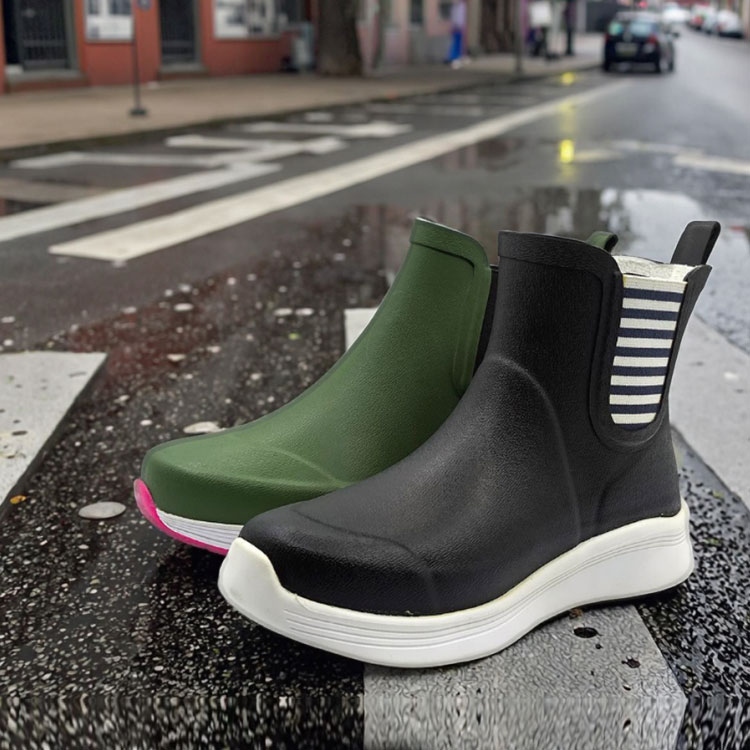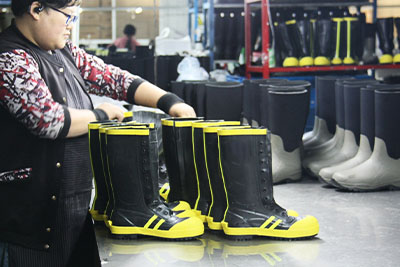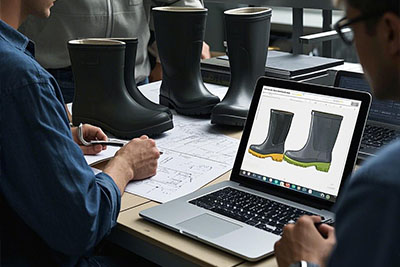Vulcanization vs Cold Cementing: Ultimate Guide to Rubber Boot Manufacturing for Waterproof Wellies
Overview
In the world of waterproof footwear, knowing how rubber boots are made is key to picking or crafting top-notch wellington boots, rain boots, or outdoor wellies. Whether it’s a business needing sturdy adult fashion wellies, tough outdoor wellies, or custom kids’ rubber boots, understanding vulcanization versus cold cementing makes a big difference. This guide dives into these two main ways to make rubber boots. It covers their perks, downsides, and best uses for fashion and outdoor needs. Plus, it shows how these methods ensure great waterproofing, using smart production insights to pick the right approach. Click here for our video introduction.
What is Vulcanization in Rubber Boot Production?

Vulcanization is a tried-and-true method that turns natural or synthetic rubber into a tough, stretchy material for rough settings. Found by Charles Goodyear long ago, vulcanization uses heat with sulfur or other chemicals to link rubber’s polymer chains. This makes it less sticky, more bouncy, and super bondable.
In rubber boot making, vulcanization joins the outsole to the upper by slightly melting the rubber at the joint with controlled heat (usually 140–180°C) and pressure. This creates a seamless, one-piece boot where the upper and sole are fused tight. For wellington boots, this works great for calendered or molded rubber soles, keeping the whole boot waterproof and sturdy.
Key Steps in Vulcanized Rubber Boot Production
- Preparation: The upper is shaped around a form. Uncured rubber soles are made by calendering (rolling into sheets) or molding.
- Assembly: The sole is placed on the upper, often with foxing tape to seal edges and boost bonding.
- Vulcanizing: The boot goes into a vulcanizer (autoclave). Heat and chemicals cure the rubber, making a lasting bond.
- Finishing: Extra material is trimmed. The boot is checked for flaws.
This method is common in factories making European-style wellies that meet strict rules like EU REACH, focusing on quality and eco-standards.
What is Cold Cementing and How Does It Work for EVA Soles?

Cold cementing, or cemented construction, is a modern way to make boots, especially with lightweight EVA (ethylene-vinyl acetate). EVA can’t handle vulcanization’s high heat, so glue bonds the outsole to the upper at room temp or low heat (55–65°C for drying).
Glue (often solvent-based or PU cement) is spread on the upper’s bottom and the sole’s sidewall. After drying, they’re pressed together for a strong mechanical bond. This is perfect for EVA light soles, which cut boot weight while keeping a bendy, sporty look.
Key Steps in Cold Cemented Rubber Boot Production
- Lasting: The upper is shaped and prepped for attachment.
- Gluing: Primer and cement coat the bonding surfaces.
- Sole Preparation: EVA or hybrid soles (EVA with rubber) are pre-cured and textured for grip.
- Bonding and Drying: Parts are joined and dried in a low-heat oven.
- Quality Check: The boot is tested for adhesion strength and waterproofing.
Cold cementing allows lots of design options, making it great for stylish rain boots with fun patterns or colors.
Vulcanization vs Cold Cementing: A Detailed Comparison
When looking at vulcanization versus cold cementing for rubber boot making, things like durability, waterproofing, weight, and cost matter. Here’s a clear breakdown to help pick the best method for wellington boot needs.
|
Aspect |
Vulcanization (Rubber Soles) |
Cold Cementing (EVA Soles) |
|
Bonding Method |
Heat and chemical curing for seamless fusion |
Adhesive gluing with low-heat drying |
|
Durability |
Super tough; resists delamination, tears, wear |
Decent for light use; may split under heavy stress |
|
Waterproofing |
Awesome; one-piece seal stops leaks |
Reliable if glued well; seams can leak |
|
Weight |
Heavier due to thick rubber |
Lighter, great for all-day comfort |
|
Flexibility |
Bendy yet sturdy; holds shape in cold |
Very bendy; sporty feel for fashion boots |
|
Cost |
Higher cost but lasts longer |
Cheaper; faster to make |
|
Design Variety |
Limited by heat; best for classic styles |
Lots of options; easy to add prints, textures |
|
Environmental Impact |
Uses natural rubber; GRS/FSC certified options |
EVA is synthetic but recyclable in some cases |
Vulcanization shines for boots that handle tough outdoor conditions. Cold cementing offers flexibility for stylish, light designs.
Benefits of Vulcanized Rubber Boots for Outdoor Use
For outdoor wellies, vulcanized rubber boots are top-notch due to their awesome durability and waterproofing. The chemical bond leaves no weak spots for water to sneak in, perfect for muddy fields, rainy hikes, or farm work. Perks include:
- Great Durability and Longevity: Vulcanized boots resist scrapes, punctures, and extreme temps, lasting years with few flaws. Many come with a 6-month quality guarantee.
- Top-Notch Waterproofing: The seamless build seals the whole boot, ideal for heavy rain or puddles.
- Heat and Chemical Resistance: Great for safety work boots, meeting standards like EU20345 S5.
- Grip and Stability: Rubber soles give excellent traction on wet surfaces, with heel support for rough ground.
- Sustainability: Factories using natural rubber with GRS and FSC certifications ensure green production.
These make vulcanized boots a prime pick for adult outdoor wellies, where reliability is key.
Advantages of Cemented EVA Boots for Fashion and Lightweight Applications
Cemented EVA boots stand out for fashion and casual use, balancing comfort and style without the bulk of rubber. They’re popular for kids’ wellies and women’s fashion rain boots, where weight and looks matter.
- Lightweight Comfort: EVA cuts boot weight by up to 30%, making them easy for long wear, like walking in city rain or playing outside.
- Design Flexibility: Allows vibrant prints, neoprene linings, and custom bits like handles, buckles, or cartoon patches—great for unique brand looks.
- Shock Absorption and Cushioning: EVA’s foam-like feel gives better impact protection, easing foot tiredness.
- Affordability and Variety: Lower costs allow diverse styles, from foldable wellingtons to chelsea rain boots.
- Breathability Options: Pair with linings like air mesh or polar fleece for seasonal use.
For fashion wellies showing off ankle curves and leg style, cemented EVA gives a sporty, modern vibe.
Waterproofing Techniques in Modern Rain Boot Manufacturing
Both methods focus on waterproofing, but techniques differ. Vulcanization makes a natural seal through fusion, boosted by wax treatments or neoprene linings for warmth. Cold cementing uses high-quality glues and seam sealing, often with transfer films for patterned uppers that stay water-resistant.
Other techniques include:
- Injection Molding: For PVC or rubber, ensuring seamless builds.
- Lining Choices: Neoprene for waterproof warmth, cotton blends for airiness.
- Certifications: EU REACH ensures chemical safety, while GRS/FSC supports green sourcing.
These keep wellies dry in heavy rain, with low defect rates in quality-focused factories.
Choosing the Right Manufacturing Process for Your Wellington Boots
Picking between vulcanization and cold cementing depends on the target market. For outdoor toughness, go for vulcanized rubber boots with strong soles. For fashion and kids’ lines, cemented EVA offers lightness and custom options. Consider factory abilities: a 20,000㎡ facility with 260+ workers and 150K pairs monthly can handle both, exporting to 50+ countries.
Factors to think about:
- End-Use: Outdoor vs. fashion.
- Budget: Vulcanization for premium, cementing for volume.
- Customization: Cementing for OEM/ODM prints and linings.
- Regulations: Ensure EU REACH and BSCI compliance.
Partner with Handan Trendy Boot and Textile Co., Ltd. for Premium Rubber Boot Manufacturing
Need a reliable partner for high-quality, EU REACH-compliant wellington boots using advanced vulcanization or cold cementing? Handan Trendy Boot and Textile Co., Ltd., a top vulcanized rubber boot factory in Hebei Province, China, specializes in quadruple-guaranteed (Quality, Environment, Technology, Service) production of adult fashion wellies, outdoor wellies, kids’ rubber boots, and more. With over 60 years of expertise, a 20,000㎡ facility, 260+ employees, and 150,000 pairs monthly capacity, they export to 50+ countries and offer full ODM/OEM services with custom prints, neoprene linings, and patented designs. Contact them at info@trenboot.com or visit www.trenboot.com to discuss business needs, request samples, and build a brand with waterproof, durable boots that shine in the global market!









